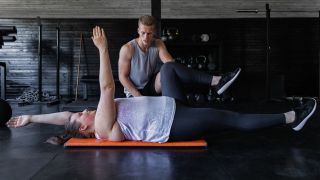How To Do The Dead Bug Exercise
Develop core strength and stability with this simple balancing bodyweight exercise

The dead bug might sound like a dance move, but in fact it’s a safe and effective core exercise which is widely used across a number of settings. Variations of the dead bug exercise are performed in Pilates to develop abdominal strength and pelvic stability, and Coach staffers have been prescribed it by numerous physios after sundry running injuries to improve core strength and reduce the chances of future injury.
It also works as both an exercise to make you a faster runner and a home exercise for cyclists to build strength and resilience to injury. It’s an excellent move for beginners too because it doesn’t put excess strain on your lower back, which can be a concern with sit-ups and many other common abs exercises.
Which muscles does the dead bug work?
We asked Cara D’Orazio, a certified personal trainer and owner of CGM Fitness, that very question. Here's how she broke it down for us:
- Transverse abdominis
- Pelvic floor
- Erector spinae (the lower back or lumbar spine)
- Obliques
- Rectus abdominis
How To Do A Dead Bug
Lie flat on your back with your arms extended towards the ceiling. Then lift your legs and bend your knees at 90° so your lower legs are parallel with the floor. Engage your core and draw your bellybutton in to get your back as flat against the floor as possible—you shouldn’t be able to get a hand in between your back and the floor, and you need to maintain this throughout.
Slowly lower your right arm behind your head and extend your left leg forwards at the same time, exhaling as you go. Keep going until your arm and leg are just above the floor, being careful not to raise your back off the floor. Then, as you inhale, slowly return to the starting position and repeat with the opposite limbs.
Dead Bug Form Tips

“The point of the dead bug is to train your deep core but also spine stabilization,” says D’Orazio. “So you want to keep your core tight and your pelvis down on the mat without letting it wiggle back and forth when you’re moving your arm and leg.”
When your leg is extended you want it to be just above the floor. How far above may be dictated by your core strength. “If you feel it in your lower back, that means the leg is dropping a little bit too low for you,” says D’Orazio.
Dead Bug Variations
Kettlebell dead bug
To progress the dead bug, hold a kettlebell in one hand while you lower and raise your other arm and its opposite leg. Don’t lower the kettlebell. Do all the reps on one side, then switch sides.
Get the Coach Newsletter
Sign up for workout ideas, training advice, reviews of the latest gear and more.

Nick Harris-Fry is a journalist who has been covering health and fitness since 2015. Nick is an avid runner, covering 70-110km a week, which gives him ample opportunity to test a wide range of running shoes and running gear. He is also the chief tester for fitness trackers and running watches, treadmills and exercise bikes, and workout headphones.
- Lois MackenzieFitness writer
